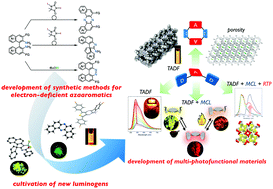Alchemy of donor–acceptor–donor multi-photofunctional organic materials: from construction of electron-deficient azaaromatics to exploration of functions
Abstract
Electron-deficient azaaromatics play crucial roles in organic material fields. Therefore, the development of synthetic methods for electron-deficient azaaromatics and the exploration of their properties and functions is important for the advancement of materials sciences and related research fields. In this Feature Article, we describe new synthetic methods for exotic electron-deficient azaaromatics and their utilization in the design of multi-photofunctional organic materials. The key findings involve a novel oxidative skeletal rearrangement of binaphthaenediamines to give U-shaped azaaromics, i.e., dibenzo[a,j]phenazine, in good yields. The unique physicochemical features of the dibenzophenazine allow for the development of multi-photofunctional organic materials based on a U-shaped and twisted electron-donor–acceptor-donor scaffold. The developed compounds exhibit efficient thermally activated delayed fluorescence, mechanochromic luminescence, and room-temperature phosphorescence, and they serve as emissive materials in organic light-emitting diodes.



 Please wait while we load your content...
Please wait while we load your content...